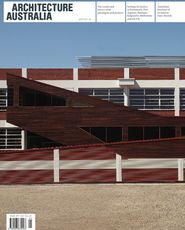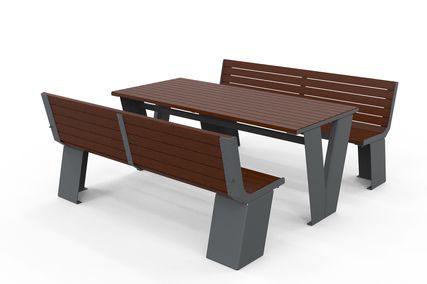Melbourne HQ Part 2
We write in relation to the letter by Jim Gall (Architecture Australia July/August 2009, vol 98 no 4) regarding the recent design competition run by the Institute for the redevelopment of its 41 Exhibition Street site in Melbourne, and the writer’s commentary on the selected winner (unnamed in his letter but authored by our practice). As a practice we love a diatribe, but not when it drifts so far from reality, or is so full of errors of fact and lapses (with malapropic absurdity) into some of the more tedious stereotypes of our profession and its design practices.
Firstly a few facts. The writer chastises the Institute for a missed opportunity to generate ideas about “the deepening concern for the environment and sustainability”. In fact, the Institute ran the competition with sustainability at the centre of its project aspirations. Our winning design, which we have now developed for DA submission, will meet, at a minimum, national leadership within the Green Star regime. Moreover the proposal has been assessed and designed to achieve carbon reductions to zero over the life cycle of the building, potentially making it the first commercial building in Melbourne to be offered to the market on such a basis – complete with a sustainability charter for investors. This seems to us to be entirely the right space for the Institute to be in as an industry leader. Modesty prevents us from expanding too much about our practice’s own work in this area, having authored two of the first ten Australian excellence-level Green Star projects, and having garnered a United Nations award and two Institute National Sustainability Awards in the last four years – a record which hardly warrants Jim’s lecture.
As with many architects, at the heart of Jim’s problem with the project design seems to be the fact that the architecture is sustainable without looking sustainable. The inference in his assessment is that architecture is not “serious” if it dares both to be sustainable and to speculate on other things – like concepts, for instance. As if building with less must also diminish our minds. A more subtle, and pernicious, inference is that to speculate on the latter is at best an indulgence, and at worst unethical in the face of the sustainability crisis. The present crisis seems to draw out the most Calvinist moralities of our profession – we are all to remain chaste, or failing that, kill off our dreams. Of course the reality is that architecture can and must do both – sustainability and “concepts” are not mutually exclusive. On the contrary, sustainability is an opportunity for reciprocity and mutuality in architectural ideas.
The second proposition that Jim offers is that we all need to be “rational” (and presumably very earnest) in the face of the crisis – and that “rational” equates to “serious”. Our design is characterized as “facilitating just comfortable subjectivity and irrationality”. This narrow view coalesces directly with the Howard years just past, where “practical” and “sensible” were rhetorical euphemisms for blindsiding the marginal, the different, the multicultural, the “themes and stews” of postmodernism, and anything else that is just plain interesting in our culture. Make no mistake, the euphemisms in Jim’s letter have the same effect within the architectural discourse. From our practice’s point of view, we can only lament a world view that can’t make space for the irrational, the crooked line, the disarming metaphor, the joy of language or the magic of the paradoxical.
Which leads us directly to the next proposition, where the writer claims the competition and our winning design was a missed opportunity to “express something more than consumerism and insubstantial fun”. If Jim’s challenge is to express what he regards as “serious concerns”, where does that lead us – do we “express” dwindling resources, or “express” minimal embodied energy, or “express” global warming or energy savings or, while we are at it, let’s just “express” the end of the world as we know it. Suddenly even the fun in insubstantial fun has a kind of appeal. As a practice we prefer a more optimistic and generous idea for architecture, within the inclusive mutuality described above. We do sustainable, but we express as many other ideas as we can lay our minds on.
Lastly the writer indulges in the most tedious of all propositions, running down the present by talking up a new future. He finishes his letter with a statement that the future is where the “opportunities for architecture are becoming massive”, and characterizes our design as both an “old paradigm” and “retro avant-garde” – quite a feat. Suffice to say that the “out with the old and in with the new” has never, never really taken us anywhere. Like it or not we are in a continuum of effort and ideas, and in a complex world that is much more than rational or simply a “problem to be solved”, and the architect’s job is to wrestle all of these crazy, exciting, contradictory, serious, inspiring and urgent threads together into our projects.
Carey Lyon, Director, Lyons
Go Melinda
Congratulations Melinda Dodson! It’s a relief to see a young woman in the role of president – a good sign that the Institute isn’t completely moribund – but it’s exciting and more than a little refreshing to see what she has to say. After years of the “same old same old”, while the climate and biosphere have been collapsing around us, finally we get to see the formal head of our profession taking a leadership role on the absolutely vital issue of turning our cities around from being gas-guzzling, land-wrecking sprawling behemoths and into places of human purpose that fit the planet’s biophysical processes (that’s what “sustainable” is supposed to mean, I think, but the word has been so mistreated as to have lost most of its meaning).
But what an uphill battle Ms Dodson has ahead of her! All of us who have been blathering on about ecology-society-architecture-cities-sustainability and climate change for too many years will know how recalcitrant and often wilfully obstructive some of our professional colleagues can be about really taking on board the issues because it all gets in the way of their aestheticism. How good, then, to see Jim Gall’s letter get an airing in the July/August issue, with his superbly sharp observations about “the crest of an old wave” designing “the most advanced punch-card system for computer data”. Like the man says, it’s time to really think.
Not only is it time for the Dodson-type thinkers of the profession to take the lead, it is also high time that Architecture Australia started publishing building critiques that treated climate and ecological impacts with something of the seriousness they deserve because, to paraphrase Jim Gall, too much lauding of the retro avant-garde really is sad.
Paul Downton
A Public Voice, Part II
Following my letter “A Public Voice” (Architecture Australia Jan/Feb 2009, vol 98 no 1) and Grahame Legge’s letter “Greenfield Architects” (Architecture Australia May/June 2009, vol 98 no 3), I write to invoke further discussion.
I must disclose that I have split my life between two countries, as an architect in Brisbane (1960–1970) and in the USA (1970–2000), with two years in Sydney (1980–1982). So I have gaps in my knowledge and understanding of Australia.
My insight is that a difference between architecture in the USA and Australia is that the former controls design through strong national codes and local authorities like planning commissions, design review boards and homeowner associations, with accompanying “design police” for conformity, whereas here we have a more subjective case-by-case approach, leaving architects and clients with much uncertainty.
The US process is more democratic, with direct access and stakeholder participation, and produces more homogeneous design with less horror.
In Australia the process is more authoritative, with lengthy, costly review and appeal, and planners rather than architects holding the strings. It produces varied results, including the high art that Australian architects provide (we punch above our numbers, as international publications reveal) but also horrors in our townscape and in the mass housing market that is so visible.
Neither the USA nor Australia has the balance achieved by Scandinavian countries, where well-designed built environments exist and also some excellent individual architecture.
Australia fails with basic design control issues. We have housing horror in our project developments and also land use abuse. Outside of urban environments, in our suburbs and towns we permit land to be both overbuilt and under-built, cleared and re-contoured. We build houses that are bloated on their lots or isolated within acreage lots. Houses deny view, daylight, orientation and ventilation, and compensate with central airconditioning. In the 60s and 70s architects such as Pettit + Sevitt in Sydney provided quality design for developers. Their ideas were the leadership in the product. Today architects are employed by housing developers but they are more subservient to the process. When you look at the result you know who is the dog and who is the walker.
Our suburbs become walled and locked lots without encouragement for neighbourly life. We have private lives, not community lives, with social and theft problems.
As architects we may abhor all this, but we have not prevented it. We don’t take seriously our responsibility to the total built environment in the way we expect our medicos to take seriously our general health as a nation. If we were doctors we would be sued for malpractice!
I believe that correction or change cannot come from individual architects, groups or even the Institute entity. (Grahame Legge speaks of his and others’ failed attempts.) It must come from wider involvement that includes political, legal and public policy entities. Our voice is mostly contained within this publication and similar others. That voice is not in the parliament, in newspapers or on TV. The public are not hearing our advice and knowledge.
We are talented; we have ability, insight and intelligence, but a shyness about the public arena. We are absent in areas where we are the authority. Until we obtain “ownership” of the built environment we cannot control its product. The size and cost of the construction industry is too big for architects’ financial ownership, but we should own the culture of the industry, and we don’t.
The route to this ownership cannot be obtained entirely through the Institute or architects with my kind of gripes. We have to be vital players in the power base of our built environment. I suggest the following:
- Educate architects to expect that their responsibility is the design of the total built environment.
- Broaden education into allied disciplines including public arena, political, media and regulatory involvement.
- Encourage some students to recognize that their talents can be better used in these areas than as “design” architects. (The Gold Medal in architecture has made a recent shift from the individual “artist” architect towards recognizing the role of teamwork and leadership.)
- Sponsor architects to enter the public arena, the media, politics, local government and regulatory authorities, all areas where our knowledge is better than or equal to others in those positions.
I wonder if the times are gone for single-voice advocacy. Networks, teams, negotiations and the common ground of stakeholders are the buzz words of contemporary influence. That is why I suggest a branch of architecture as the perch for some architects – to be a voice, an influence on and controller of our industry. I think of architecture as our responsibility to the totality of building. This is the changed mindset I am encouraging.
Ultimately architecture can’t be just what we see in this magazine; it should be what we see around us.
John Railton, FRAIA















